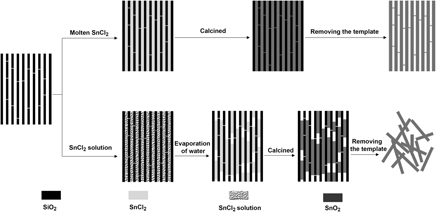Crossref Citations
This article has been cited by the following publications. This list is generated based on data provided by
Crossref.
Wang, Xiujuan
Wang, Gang
Zhai, Gaohong
and
Wang, Hui
2014.
Preparation and electrochemical evaluation of NiO nanoplatelet-based materials for lithium storage.
Journal of Materials Research,
Vol. 29,
Issue. 13,
p.
1393.
QIN, Liping
LIANG, Shuquan
TANG, Yan
TAN, Xiaoping
and
ZHOU, Jiang
2015.
Influence of PVP on Solvothermal Synthesized Fe<sub>3</sub>O<sub>4</sub>/Graphene Composites as Anodes for Lithium-ion Batteries.
Electrochemistry,
Vol. 83,
Issue. 8,
p.
619.
Morachevskii, A. G.
2015.
Thermodynamic properties and electrochemical studies of lithium-tin alloys.
Russian Journal of Applied Chemistry,
Vol. 88,
Issue. 7,
p.
1087.
Jeong, Jaehyang
Reece, Michael J.
and
Pyo, Myoungho
2015.
Improved Lithium-Storage Capability and Cyclability of Tin Dioxide Confined in Highly Crosslinked Graphene Framework.
Journal of The Electrochemical Society,
Vol. 162,
Issue. 9,
p.
A1702.
Park, Gwi Ok
Hyung, Eunbyeol
Shon, Jeong Kuk
Kim, Hansu
and
Kim, Ji Man
2015.
Highly Ordered Mesoporous Antimony-Doped SnO2 Materials for Lithium-ion Battery.
Nano,
Vol. 10,
Issue. 06,
p.
1550090.
Vásquez, F.C.
Paraguay-Delgado, F.
Morales-Mendoza, J.E.
Antúnez-Flores, W.
Lardizabal, D.
Alonso-Nuñez, G.
and
Berhault, G.
2016.
Shape and size controlled growth of SnO2 nano-particles by efficient approach.
Superlattices and Microstructures,
Vol. 90,
Issue. ,
p.
274.
Zhao, Hu
Liu, Lei
Hu, Zhongbo
Sun, Limei
Han, Songbai
Liu, Yuntao
Chen, Dongfeng
and
Liu, Xiangfeng
2016.
Neutron diffraction analysis and electrochemical performance of spinel Ni(Mn2−Co )O4 as anode materials for lithium ion battery.
Materials Research Bulletin,
Vol. 77,
Issue. ,
p.
265.
Hou, Chau-Chung
Brahma, Sanjaya
Weng, Shao-Chieh
Chang, Chia-Chin
and
Huang, Jow-Lay
2017.
Facile, low temperature synthesis of SnO 2 /reduced graphene oxide nanocomposite as anode material for lithium-ion batteries.
Applied Surface Science,
Vol. 413,
Issue. ,
p.
160.
Kholiya, Kuldeep
and
Pandey, Kailash
2019.
High pressure compression behaviour of bulk and nanocrystalline SnO2.
Journal of Taibah University for Science,
Vol. 13,
Issue. 1,
p.
592.
Brahma, Sanjaya
Weng, Shao‐Chieh
Huang, Jow‐Lay
and
Huang, Jow‐Lay
2019.
Handbook of Graphene.
p.
323.
Du, Guangyu
Xu, Yuxia
Zheng, Shasha
Xue, Huaiguo
and
Pang, Huan
2019.
The State of Research Regarding Ordered Mesoporous Materials in Batteries.
Small,
Vol. 15,
Issue. 11,
Herdt, Tim
Deckenbach, Daniel
Bruns, Michael
and
Schneider, Jörg J.
2019.
Tungsten oxide nanorod architectures as 3D anodes in binder-free lithium-ion batteries.
Nanoscale,
Vol. 11,
Issue. 2,
p.
598.
Zoller, Florian
Böhm, Daniel
Bein, Thomas
and
Fattakhova‐Rohlfing, Dina
2019.
Tin Oxide Based Nanomaterials and Their Application as Anodes in Lithium‐Ion Batteries and Beyond.
ChemSusChem,
Vol. 12,
Issue. 18,
p.
4140.
Ibrahim, Amr Awad
Hassan, Shawky M.
and
Mannaa, Mohammed A.
2020.
Mesoporous tin oxide-supported phosphomolybdic acid as high performance acid catalysts for the synthesis of hydroquinone diacetate.
Colloids and Surfaces A: Physicochemical and Engineering Aspects,
Vol. 586,
Issue. ,
p.
124248.
Wu, Yi-Zhu
Brahma, Sanjaya
Weng, Shao-Chieh
Chang, Chia-Chin
and
Huang, Jow-Lay
2020.
Reduced graphene oxide (RGO)-SnOx (x=0,1,2) nanocomposite as high performance anode material for lithium-ion batteries.
Journal of Alloys and Compounds,
Vol. 818,
Issue. ,
p.
152889.
Nakamura, Ryunosuke
Kasai, Hidetaka
Fujita, Tomoki
Akamine, Hiroshi
Hata, Satoshi
and
Nishibori, Eiji
2021.
Critical Length for Lattice Expansion of SnO2 Nanorods and Nanosheets: Implications for Lithium-Ion Batteries.
ACS Applied Nano Materials,
Vol. 4,
Issue. 9,
p.
9938.
Ragupathi, Veena
Lokeswararao, Y.
Mitra, Soumyadip
and
Sudakar, C.
2023.
Promising electrochemical performance of pristine SnO2 anodes for lithium and sodium-ion batteries.
Journal of Electroanalytical Chemistry,
Vol. 943,
Issue. ,
p.
117625.
Suman, Pedro H.
Jorgetto, Alexandre O.
Romeiro, Fernanda C.
Felix, Anderson A.
Morais, Paulo V.
Melquíades, Miécio O.
and
Orlandi, Marcelo O.
2023.
1D Semiconducting Hybrid Nanostructures.
p.
97.



